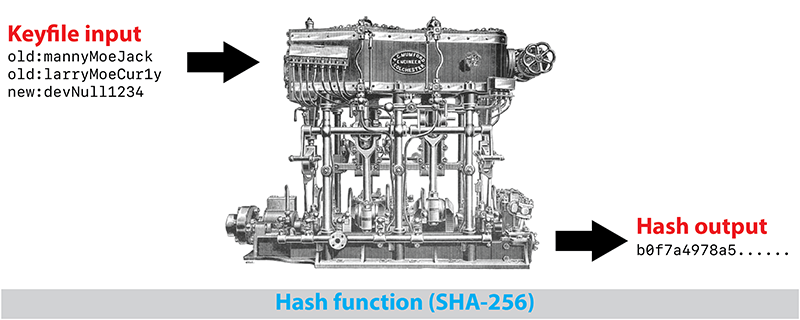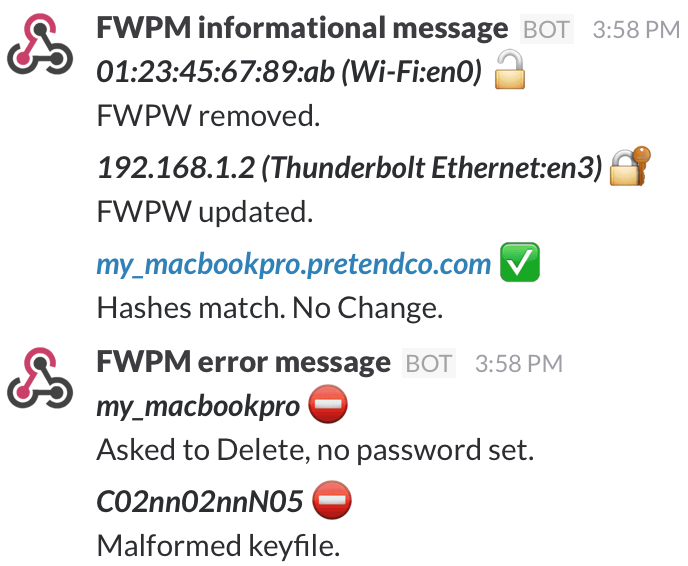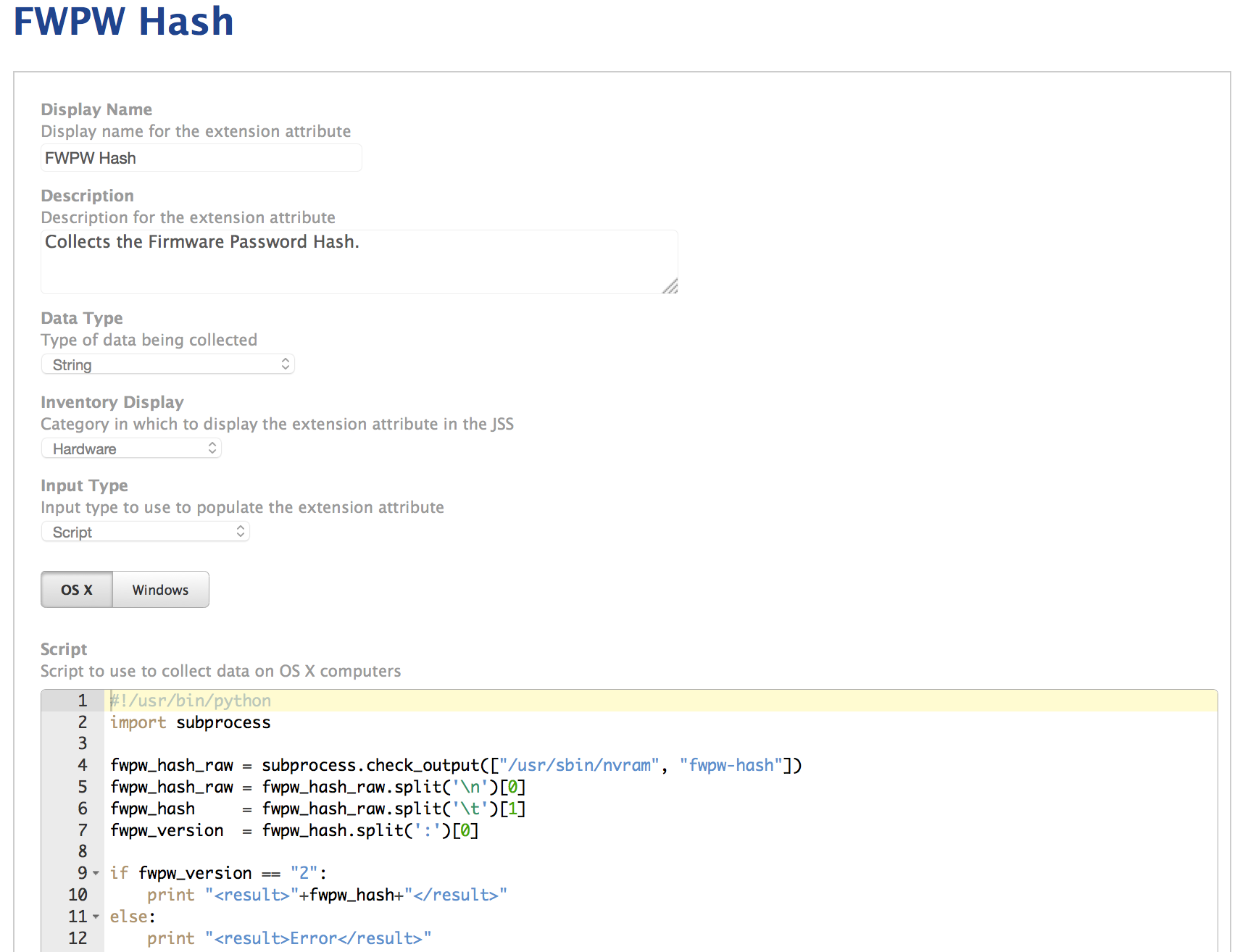A Python script to help Macintosh administrators manage the firmware passwords of their computers.
- Download - get the .dmg
- Contact
- System Requirements
- Install
- Uninstall
- Purpose
- Usage
- Notes
- Update History
Download the latest installer here!
If you have any comments, questions, or other input, either file an issue or send us an email. Thanks!
- Python 2.7+ (which you can download here)
- Pexpect 3.3+ (which you can download here)
- Management Tools - version 1.6.0 or greater
Place the script in a root-executable location. We use /usr/local/sbin/. Make sure it is executable.
Remove the script.
In a nutshell, the firmware password in Apple computers prevents non-privileged users from booting from a foreign device.
The firmware password is one of three interlocking methods used to secure Apple computers. The other two are: using strong passwords on user accounts and FileVault to apply full disk encryption (FDE). Strong account passwords are always the first line of defense. FDE effectively scrambles the information written a storage device and renders it unreadable by unauthorized persons. Using all three methods can make a computer unusable should it be lost or stolen.
Depending on the model of computer, removing the firmware password can be easy or incredibly difficult, please refer to the Notes section for more information about removing the password.
When I began this project there wasn't a solution available for actively managing firmware passwords, other than the "set-it-and-forget-it" method. This approach seems error-prone and difficult to maintain beyond more than a small handful of machines. My solution centers on maintaining a single list of current and formerly used passwords that I call the keyfile. This approach allows the administrator to easily bring any number of machines up to the current password, and identify those whose firmware passwords aren't in the master list and need additional maintenance.
firmware_password_manager.py will use your keyfile to set a firmware password on a machine with no existing firmware password, attempt to change the existing firmware password to your new password or remove the current password. The script is best used when it can be installed and left on the machine for future use. This allows the admin to then create an installer package containing the keyfile and a postflight action to run FWPM. Or the admin could create a launchagent to run FWPM at every boot
Version 2 represents a complete rewrite of Firmware Password Manager (FWPM). The previous version, a shell script, always felt brittle to me. The new version is written in Python. I also focused on utilizing firmwarepasswd, rather than the outdated setregproptool.
When FWPM successfully sets or changes the firmware password it computes a hash based on the contents of the keyfile and stores the results in nvram. When FWPM is run again on a client it will compare the hash of the current keyfile and the hash stored on the machine, if they are different it will signal the need to change the firmware password to a new value.
A hash can be thought of as the finger print of a file. The goal of a hash function is that no two files will share the same hash value. FWPM uses SHA-256 to generate the hash, or the SHA-2 hash function at a length of 256 bits (32 bytes). Rather than simply hashing the password itself, FWPM hashes the entire keyfile for additional security.
firmware_password_manager.py [-h -v] [-# -r -m -n] [-k /path/to/keyfile -o] [-s -i] [-t]
| Flag | Purpose |
|---|---|
-h, --help |
Prints help information and quits. |
-v, --version |
Prints version information and quits. |
-r, --remove |
Remove the current firmware password. |
-m, --management |
Define management string in nvram. |
-#, --hash |
Record hash of keyfile in nvram entry. FWPW 1.0 behavior. Default choice. |
-n, --nostring |
Do not set management string. |
-k, --keyfile |
Provide the path to the keyfile. |
-t, --testmode |
More verbose logging, will not delete keyfile. |
-s, --slack |
Sends important messages to Slack. |
-o, --obfuscate |
Accepts a plist containing the obfuscated keyfile. |
-b, --reboot |
Reboots the computer after the script completes successfully. |
-i, --identifier |
Set slack identifier. IP, MAC, computername, hostname, serial |
Certain flags are mutually exclusive. The script will refuse to run if more than one of the following flags are used: -remove -management -hash -nostring
The script works with a text document I call the keyfile. It contains the new password, as well as any previously used passwords. Having previously used passwords available allows the script to update machines that may have been missed during previous runs of the script.
The script requires a specific format for the keyfile. Each lines contains the following: a note string, a colon, and a password string. No additional colons. I assume the newest passwords will be at the end of the file, and the script will try those first. Only the new note has a special meaning, others are ignored.
Here is the keyfile format:
| Notes | Purpose |
|---|---|
| new | the new password to be installed. |
| note | any other note strings are ignored. |
| #new | a hash mark will cause the note to be ignored. |
Here's an example keyfile:
previous:mGoBlue
other:brownCow
#new:short3rPasswd
new:goUtes
Version 1 made use of the current note to designate what was thought to be current password. Version 2 discovers the current password on its own and will ignore this note.
The keyfile contains, of course, incredibly sensitive information. When the script successfully completes or encounters an error, it attempts to securely delete the keyfile from the disk.
firmware_password_manager.py -s -k path/to/keyfile -#
This command will place a hash in nvram, slack informational messages and use the keyfile at path/to/keyfile.
We make heavy use of Slack in our office. The -s --slack flag directs FWPM to send informational messages to a slack team. I have integrated the slack functionality of our management_tools library into FWPM. You simply need to add the URL and channel information for your Slack group to the script.
Please see Slack's documentation for additional configuration options: https://api.slack.com/incoming-webhooks
This image shows example messages in Slack:
Version 2.1.1 adds additional configuration options for Slack. The -i --identifer flag allows you to select how machines are identified in Slack messages. This feature request was issue #2. These flags are mutually exclusive.
| String | Purpose |
|---|---|
| IP | The IP address of the machine is used. Previous default. |
| MAC | The MAC address of the current device is used. |
| computername | The computername is used. |
| hostname | The fully qualified domain name is used. |
| serial | The machines serial number is used. If an error occurs discovering the previous methods, FWPM will fall back to this method. |
To make the most of FWPM, we suggest using the -#``--hash flag to store the hash of the keyfile used to create the current firmware password. This allows you to use a variety of tools to remotely check the status of the firmware password on a machine. Using this flag the script will create an SHA-2 hash of the new keyfile and store it in non-volitile RAM (nvram) when the password is changed. The hash can then be accessed locally through the terminal or remotely with SSH, ARD or other tool.
The -m``--management flag allows you to define any string to place in nvram. You could record the date the password was changed last or a cryptic hint to help you remember the password in the future (not recommended).
Version 2 of FWPM uses Apple's firmwarepasswd tool to make changes to the firmware password. firmwarepasswd was shipped beginning with Mac OS X 10.10 "Yosemite". If you need to manage firmware passwords on OS X prior to 10.10, consider using the previous version of Firmware Password Manager.
| message | description |
|---|---|
| Keyfile does not exist. | The script was not able to find the keyfile define by the user, check the path again. |
| No Firmware password tool available. | The script was unable to find the firmwarepasswd tool. Check that it has not been moved. |
| Asked to delete, no password set. | The user selected the -r/--remove flag to remove the firmware password, but no firmware password is set. |
| Malformed keyfile key:value format required. | The keyfile is not properly formatted. Follow the instructions above. |
| Multiple new keys. | multiple passwords are defined as new in the keyfile, you will need to comment or rename the additional new keys. |
No new key. |
No password in the keyfile has the new note, you will need to properly identify the password you wish the use. |
| Asked to delete, current password not accepted. | For this error to appear something very odd and unexpected has happened, contact the author. |
| Bad response from firmwarepasswd. | This is a catchall error stating that firmwarepasswd encountered an error. |
| Current FW password not in keyfile. | This is an critical message that the keyfile does not contain the current password. |
| nvram reported error. | This is a catchall error stating that nvram encountered an error. |
| An error occured. Failed to modify firmware password. | This means one of the above errors likely occured. Keep reading the log to find the exact error. |
Version 2.1 adds an important new security feature. I've included a new tool: obfuscate_keylist.py.
obfuscate_keylist.py -s original_keylist.txt -d obfuscated_keylist.plist
| Flag | Purpose |
|---|---|
| -s, --source | path to source keyfile |
| -d, --desination | path to save obfuscated keyfile |
| -t, --testmode | verbose output |
| -v, --version | show program's version number and exit |
| -h, --help | show help message and exit |
This tool takes your original keyfile and outputs a base64-encoded property list. It's important to note that obfuscation is not technically encryption. The flag for FWPM to use this form of plist is -o, --obfuscate
I've also added a reboot flag -b, --reboot. If this flag is selected and the script finishes successfully, it will force a reboot.
Also new to this release is a sample script (remotely_set_firmpwarepassword_scp_keylist.py) showing how to remotely execute FWPM and securely copy (scp) your keyfile over the network. A shell script version is included for use in Apple's Remote Desktop.
FWPM was originally written to work with our unique management system. During the python rewrite, I made an effort to make FWPM independent of any specific administration philosophy and making it easier to integrate into future management solutions. I've included sample scripts for integrating FWPM into JAMF Casper, UNIX and ARD. The source is included in the example scripts folder.
We can leverage the nvram string and smart groups in JAMF Casper to automate the distribution of an updated keyfile package and direct clients to change their firmware passwords. We do this by defining an extension attribute (EA) in the JSS. We've included the script we run in the repository for FWPM 2.0.
The EA script runs during recon and pushes the hash up to the JSS. We then define a smart group that contains any machine not sharing the same hash as the current keyfile. This makes it possible to apply a policy directing those machines to download the new keyfile package and run FWPM.
The following image shows the EA page in the JSS:
This image shows the two possible smart group built using the EA:
Here is how the smart groups are built:
The awkwardly titled remotely_set_firmpwarepassword_scp_keylist.py script uses OpenSSH's Secure Copy command to copy the keyfile and execute FWPM.
The equally awkward ard_wrapped_remotely_set_firmpwarepassword_scp_keylist.sh script is written to use in an Apple Remote Desktop Send UNIX command.
These examples are designed to be customized with the server address, account name and password to allow scp to function. Care will be required to prevent unauthorized users from examining the contents.
If you have forgotten the firmware password for a machine your available options depend upon the age of the machine.
If the machine is a MacBook Air (Late 2010) and later, MacBook Pro (Early 2011) and later, iMac (Mid 2011) and later, and Mac mini (Mid 2011) you will need to contact Apple. Please see these pages for additional info:
https://jamfnation.jamfsoftware.com/discussion.html?id=5474 http://www.ernieflores.net/osx-page-5/recovering-a-lost-firmware-password/
If you have an earlier machine, it's much easier:
- Shutdown the machine. Remove the battery, if possible.
- Change the configuration of RAM by removing a module.
- Restart the machine and zap the PRAM 3 times. (Hold down Option, Command, p and r after you press the power botton, and wait for three restarts)
- Shut the machine down and remove the battery, if possible.
- Reinstall the RAM module.
- Restart and the firmware password should be removed.
Thank you to macmule for http://macmule.com/2014/05/11/ea-check-efi-password-state/, which helped me get things working in version 1.
| Date | Version | Notes |
|---|---|---|
| 2017.10.23 | 2.1.4 | using rm -P for secure delete, added additional alerting, additional pylint cleanup. |
| 2016.03.16 | 2.1.2 | Cleaned up argparse, removed obsolete flag logic. |
| 2016.03.16 | 2.1.1 | Slack identifier flag, logic clarifications. |
| 2016.03.07 | 2.1.0 | Obfuscation, reboot flag, bug fixes |
| 2015.11.05 | 2.0.0 | Python rewrite, Docs rewritten |
| 2015.02.25 | 1.0.1 | Added use of firmwarepasswd on 10.10 |
| 2014.08.20 | 1.0.0 | Initial version. |




